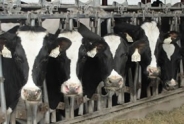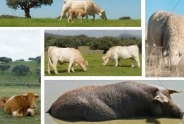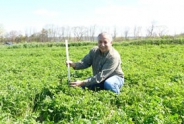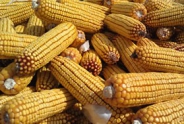First Cutting Updates - Week of May 9, 2016
Betsy Hicks, Area Dairy Specialist
South Central New York Dairy & Field Crops
May 11, 2016
The SCNY team is in the second week of monitoring alfalfa height to help predict quality and %NDF for first cutting hay crop. Alfalfa height has been proven to be a reliable indicator of NDF values in the field for alfalfa, alfalfa/grass mixed and all grass stands. Results are compiled and emailed on a weekly basis - please feel free to forward the results! If your area falls outside of our 5 county region, please contact Betsy (bjh246@cornell.edu) because there are many other counties that are participating in the weekly checks. The weekly email for the month of May has a table of the locations around the region where we have measured the alfalfa height, as well as the elevation. Even if your fields aren't measured, you can use the location and elevation as a guide to conditions that may be similar to your own.
Fields across the 5-county region have seen growth in the 4-5" range in the last week. There are several locations in southern Chemung and Tioga Counties that alfalfa has reached the 14-15" mark, which means that nearby all grass fields should be harvested for peak quality. Locations throughout Tompkins, Cortland and Broome Counties are mainly within that 10-12" height, with some higher elevations just a hair below that. This next bit of heat and rain on Friday and Saturday will really bring on some growth, so early next week could be go time for all grass harvest everywhere. It's not too soon - some farmers to our east started harvesting yesterday, so be ready to park the corn planter if you have grass fields to be harvested. Predictions for a 50/50 mix of grass and alfalfa are looking like anywhere from 5/20-5/25 for peak quality. Our report next week will give updated heights again for all fields - keep an eye out for it! Again, if you haven't taken a peek at your fields, take a drive while it's raining Friday. Remember too that Janice and I are always happy to come out to check things out!
The numbers that are indicators for using alfalfa heights for NDF content are as follows:
• 100% grass stands should be cut when nearby alfalfa is 14 inches tall, to achieve 50% NDF
• 50/50 mixed alfalfa/grass stands should be cut when nearby alfalfa is 22 inches tall, to achieve 44% NDF
• 100% alfalfa stands should be cut when alfalfa is 28 inches tall, to achieve 40% NDF
Predicted days to cut are based on daily NDF increases for grasses of 1.0% point, 50/50 mixed alfalfa/grass stands of 0.8% points, and alfalfa of 0.5% points and are adjusted for the coming week's weather. Typically NDF increases about 0.8 to 1.2 per day for grasses, with cooler weather being the lower end of the range and warmer weather being the higher end. For alfalfa, NDF increases about 0.4 to 0.7 per day, also dependent upon warm/cool weather.
Alfalfa Heights May 10 2016 (pdf; 147KB)
- download this report to view alfalfa heights around the SCNY 5 county region
Upcoming Events
Spanish Dairy Webinar Series
September 3, 2025
September 10, 2025
September 17, 2025
September 24, 2025
October 1, 2025
October 8, 2025
October 15, 2025
October 22, 2025
October 29, 2025
November 5, 2025
Daniela Gonzalez Carranza is happy to announce a collaboration with the University of Wisconsin-Madison for a dairy webinar series only in Spanish.
Dairy Systems & Technology Showcase - Cayuga County Tours
October 29, 2025 : Fall Farm Tour - Cayuga County
- Guided facility walk through of new dairy systems and technologies on farms across NYS led by CCE Dairy Specialists, PRO-DAIRY, and other industry experts.
- Intended audience: Dairy farmers and industry partners.
Dairy Systems & Technology Showcase - Cortland County Tours
November 5, 2025 : Fall Farm Tour - Cortland County
- Guided facility walk through of new dairy systems and technologies on farms across NYS led by CCE Dairy Specialists, PRO-DAIRY, and other industry experts.
- Intended audience: Dairy farmers and industry partner
Announcements
USDA Contract Freezes and Terminations: Legal Action Steps for Farmers
For Farmers with Signed EQIP and CSP ContractsThis resource is written for farmers and ranchers nationwide who have a signed contract with USDA NRCS under the EQIP or CSP program for environmental improvements but have concerns that their contract is frozen, under review, or terminated, and who are uncertain of their rights to receive reimbursement as well as their ongoing obligations under the signed contract.
Version: 1.0
Issue date: Feb 28, 2025
A downloadable factsheet is available at our BUSINESS tab on the top of our webpage.
Additional Information: www.farmcommons.org
USDA Contract Freezes: Filing an NAD Appeal or Demand Letter
This resource is written for farmers and ranchers nationwide who have a signed contract with USDA NRCS under the EQIP or CSP program for environmental improvements and want more information on the mechanics of filing a National Appeals Division (NAD) appeal. This resource includes sample letters.
USDA NAD Appeal https://www.usda.gov/about-usda/general-information/staff-offices/office-hearings-and-appeals/national-appeals-division/nad-appeals
A downloadable factsheet is available at our BUSINESS heading at the top of our webpage.
Farm Participants Needed for Bale Grazing Grant!
Information on the Project:- Approximately 10 acres total needed to bale graze two different bale densities
- "Core" farms will graze two winters, "Demo" farms will graze one winter.
- Payments for both "Core" farms and "Demo" farms
- Baseline soil sampling by bale grazing team
- Forage measurements in early season by bale grazing team
- Late season clipping if residual not trampled down by farm
Interested farms can enroll for this winter or next.
Looking for 2-3 dairy farms to enroll! If interested, please reach out to Betsy Hicks, 607.391.2673 or bjh246@cornell.edu
Cornell Cow Convos - New Podcast
On-going podcast, New episodes released on the last Thursday of the month.Guest speakers, CCE Dairy Specialists.
Housed on Soundcloud Channel is CCE Dairy Educators
Topics:
- Preventative healthcare for cows
- The trend of beef on dairy
- What to look forward to in the new year for dairy
- Socially grouping or pair-housing calves
2018 Drug Residue Prevention Manual
For more than 30 years, the U.S. dairy industry has focused educational efforts on the judicious use of antibiotics through the annual publication of a Best Practices Manual. The 2018 edition of the National Dairy FARM Program: Farmers Assuring Responsible Management? Milk and Dairy Beef Drug Residue Prevention Manual is the primary educational tool for dairy farm managers throughout the country on the judicious and responsible use of antibiotics, including avoidance of drug residues in milk and meat.The manual is a quick resource to review those antibiotics approved for dairy animals and can also be used as an educational tool and resource for farm managers as they develop on-farm best management practices necessary to avoid milk and meat residues. Visit the Manual and Form Library to download copies of this important tool!
Follow us on Facebook
The team updates our facebook page frequently - follow us to be updated on our events, see some fun videos and get local area updates!facebook.com/SCNYDairyandFieldCropsTeam
NYSERDA Agriculture Energy Audit Program
NYSERDA offers energy audits to help eligible farms and on-farm producers identify ways to save energy and money on utility bills. Reports include recommendations for energy efficiency measures.Eligibility
Eligible farms include but are not limited to dairies, orchards, greenhouses, vegetables, vineyards, grain dryers, and poultry/egg. The farms must also be customers of New York State investor-owned utilities and contribute to the System Benefits Charge (SBC). Please check your farmís current utility bills to see if your farm pays the SBC.
Energy Audit Options
You can request the level of energy audit that best fits your farmís needs. NYSERDA will assign a Flexible Technical Assistance Program Consultant to visit your farm and perform an energy audit at no cost to you.
For more information and the NYSERDA Agriculture Energy Audit Program Application click here
For more information and the NYSERDA Agriculture Energy Audit Program Application click here





